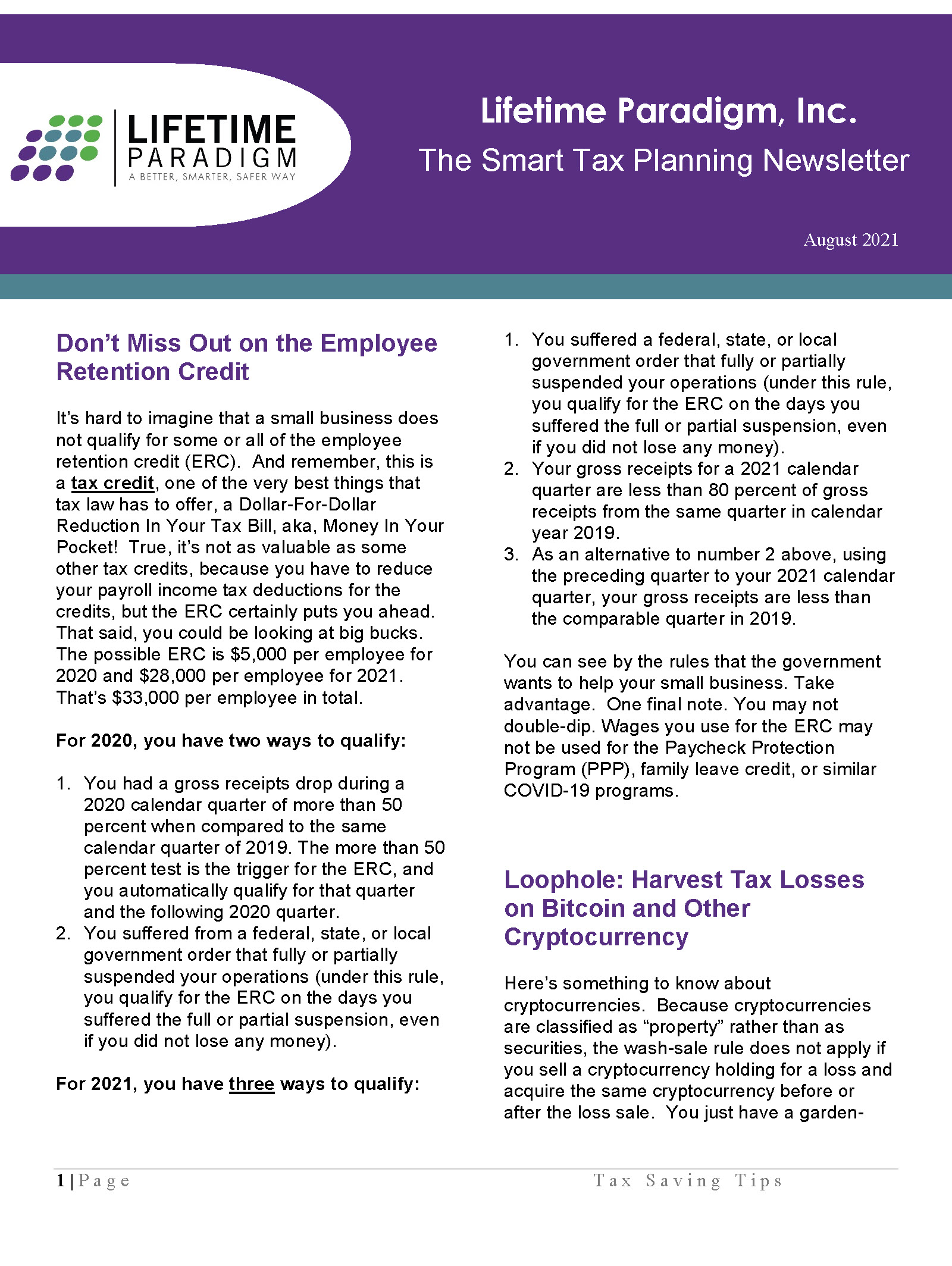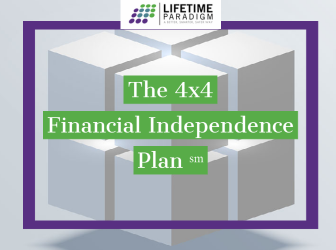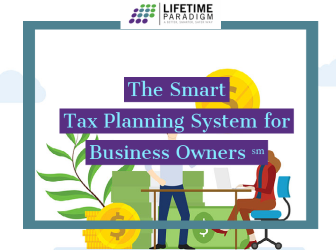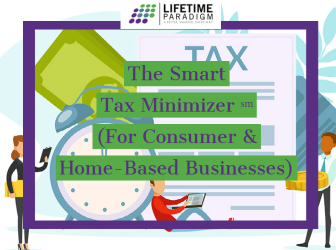Tax Planning
The Smart Tax Planning Newsletter August 2021
Every month we provide you with a fairly detailed review of several Important Tax Topics. Scan through the highlighted topics noted below.
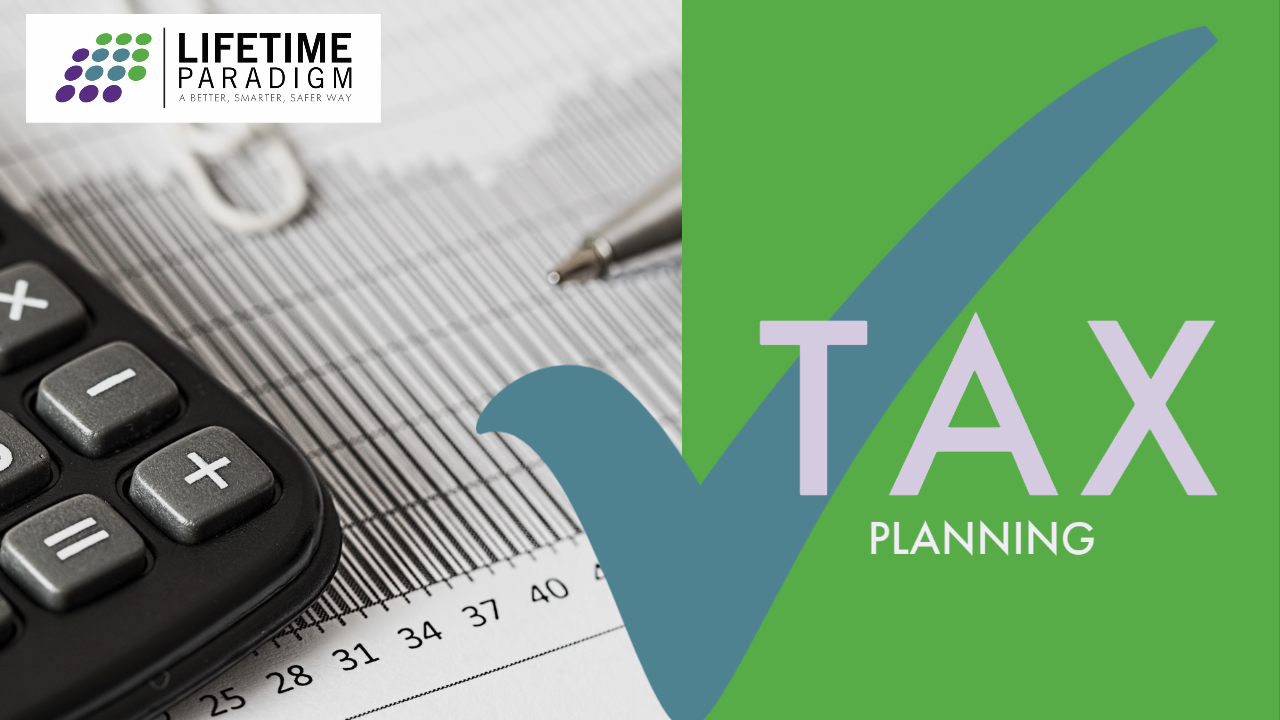
In This Month’s Newsletter We Review:
- Don’t Miss Out on the Employee Retention Credit
- Loophole: Harvest Tax Losses on Bitcoin and Other Cryptocurrency
- Don’t Make a Big Mistake by Filing Your Tax Return Late!
- The Principal Residence Gain Exclusion Break
Don’t Miss Out on the Employee Retention Credit
It’s hard to imagine that a small business does not qualify for some or all of the employee retention credit (ERC). And remember, this is a tax credit, one of the very best things that tax law has to offer, a Dollar-For-Dollar Reduction In Your Tax Bill, aka, Money In Your Pocket! True, it’s not as valuable as some other tax credits, because you have to reduce your payroll income tax deductions for the credits, but the ERC certainly puts you ahead. That said, you could be looking at big bucks. The possible ERC is $5,000 per employee for 2020 and $28,000 per employee for 2021. That’s $33,000 per employee in total.
For 2020, you have two ways to qualify:
- You had a gross receipts drop during a 2020 calendar quarter of more than 50 percent when compared to the same calendar quarter of 2019. The more than 50 percent test is the trigger for the ERC, and you automatically qualify for that quarter and the following 2020 quarter.
- You suffered from a federal, state, or local government order that fully or partially suspended your operations (under this rule, you qualify for the ERC on the days you suffered the full or partial suspension, even if you did not lose any money).
For 2021, you have three ways to qualify:
- You suffered a federal, state, or local government order that fully or partially suspended your operations (under this rule, you qualify for the ERC on the days you suffered the full or partial suspension, even if you did not lose any money).
- Your gross receipts for a 2021 calendar quarter are less than 80 percent of gross receipts from the same quarter in calendar year 2019.
- As an alternative to number 2 above, using the preceding quarter to your 2021 calendar quarter, your gross receipts are less than the comparable quarter in 2019.
You can see by the rules that the government wants to help your small business. Take advantage. One final note. You may not double-dip. Wages you use for the ERC may not be used for the Paycheck Protection Program (PPP), family leave credit, or similar COVID-19 programs.
Loophole: Harvest Tax Losses on Bitcoin and Other Cryptocurrency
Here’s something to know about cryptocurrencies. Because cryptocurrencies are classified as “property” rather than as securities, the wash-sale rule does not apply if you sell a cryptocurrency holding for a loss and acquire the same cryptocurrency before or after the loss sale. You just have a garden-variety short-term or long-term capital loss, depending on your holding period. No wash-sale rule worries. This favorable federal income tax treatment is consistent with the long-standing treatment of foreign currency losses. That’s a good thing, because folks who actively trade cryptocurrencies know that prices are volatile.
This volatility gives you two opportunities:
- Profits on the Upswings
- Loss Harvesting on the Downswings
Let’s take a look at the harvesting of losses:
- On day 1, Lucky pays $50,000 for a cryptocurrency.
- On day 50, Lucky sells the cryptocurrency for $35,000. He captures and deducts the $15,000 loss ($50,000 – $35,000) on his tax return.
- On day 52, Lucky buys the same cryptocurrency for $35,000. His tax basis is $35,000.
- On day 100, Lucky sells the cryptocurrency for $15,000. He captures and deducts the $20,000 loss ($35,000 – $15,000) on his tax return.
- On day 103, Lucky buys the same cryptocurrency for $15,000.
- On day 365, the cryptocurrency is trading at $55,000. Lucky is happy.
Observations:
- Assuming Lucky had $35,000 in capital gains, Lucky deducted his $35,000 in cryptocurrency capital losses. If he had no capital gains, he had a $3,000 deductible loss and carried the other $32,000 forward to next year.
- On day 365, Lucky has his cryptocurrency, which was his plan on day 1. He thought it would go up in value. It did, from its original $50,000 to $55,000.
- Lucky’s tax basis in the cryptocurrency on day 365 is $15,000.
Here’s what Lucky did:
- He kept his cryptocurrency.
- He banked $35,000 in losses.
Be alert – Losses from crypto-related securities, such as Coinbase, can fall under the wash-sale rule because the rule applies to losses from assets classified as securities for federal income tax purposes. For now, however, cryptocurrencies themselves are not classified as securities.
Planning point. If you want to harvest losses, make sure you hold a cryptocurrency and not a security!
Don’t Make a Big Mistake by Filing Your Tax Return Late!
Three bad things happen when you file your tax return late.
What’s Late?
You can extend your tax return and file during the period of extension; that’s not a late-filed return. The late-filed return is filed after the last extension expired. A “late-filed return causes the three bad things to happen.
Bad Thing 1
The IRS notices that you filed late or not at all. Of course, the “I didn’t file at all” people receive the IRS’s “come on down and bring your tax records” letter. In general, the meeting with the IRS about non-filed tax returns does not go well.
For the late filers, the big problem is exposure to an IRS audit. Say you’re in the group that the IRS audits about 3 percent of the time, but you file your tax return late. Your chances of an IRS audit increase significantly, perhaps to 50 percent or higher. Simply stated, bad thing 1 is this: file late and increase your odds of saying “Hello, IRS examiner.”
Bad Thing 2
When you file late, you trigger the big 5 percent a month, not to exceed 25 percent of the tax-due penalty. Here, the bad news is 5 percent a month penalty. The good news, if you want to call it that, is this penalty maxes out at 25 percent.
Bad Thing 3
Of course, if you owe the “failure to file” penalty, you likely also owe the penalty for “failure to pay.” The failure-to-pay penalty equals 0.5 percent a month, not to exceed 25 percent of the tax due. The penalty for failure to pay offsets the penalty for failure to file such that the 5 percent is the maximum penalty during the first five months when both penalties apply. However, once those five months are over, the penalty for failure to pay continues to apply. Thus, you can owe 47.5 percent of the tax due by not filing and not paying (25 percent plus 0.5 percent for the additional 45 months it takes to get to the maximum failure-to-pay penalty of 25 percent).
The Principal Residence Gain Exclusion Break
The $250,000 ($500,000, if married) home sale gain exclusion break is one of the great tax-saving opportunities. Unmarried homeowners can potentially exclude gains up to $250,000, and married homeowners can potentially exclude up to $500,000. You as the seller need not complete any special tax form to take advantage. To take full advantage of the principal residence gain exclusion break, you must pass two tests: the ownership test and the use test.
- To pass the ownership test, you must have owned the home for at least two years out of the five-year period ending on the sale date.
- To pass the use test, you must have used the home as your principal residence for at least two years out of the five-year period ending on the sale date.
Key point. These two tests are completely independent. In other words, periods of ownership and use need not overlap.
If you’re married and you and your spouse file your tax returns separately, you can potentially qualify for two separate $250,000 exclusions. If you’re married and file jointly, you qualify for the $500,000 joint-filer exclusion if:
- either you pass or your spouse passes the ownership test for the property and
- both you and your spouse pass the use test.
When you file jointly, it’s also possible for both you and your spouse to individually pass the ownership and use tests for two separate residences. In that case, you and your spouse would qualify for two separate $250,000 exclusions. Each spouse’s eligibility for the $250,000 exclusion is determined separately, as if you were unmarried. For this purpose, a spouse is considered to individually own a property for any period the property is actually owned by either spouse.
The other big qualification rule for the home sale gain exclusion privilege goes like this:
The exclusion is generally available only when you have not excluded an earlier gain within the two-year period ending on the date of the later sale. In other words, you generally cannot recycle the gain exclusion privilege until two years have passed since you last used it.
You can claim the larger $500,000 joint-filer exclusion only if neither you nor your spouse took advantage of it for an earlier sale within the two-year period. If one spouse claimed the exclusion within the two-year window but the other spouse did not, the exclusion is limited to $250,000.
SERVICES WE OFFER RELATED TO THIS TOPIC
The information contained in this post is for general use and educational purposes only. However, we do offer specific services to our clients to help them implement the strategies mentioned above. For specific information and to determine if these services may be a good fit for you, please select any of the services listed below.


For more information on tax planning, visit our Tax Planning page to see our list of services.
EP 0012. The Three Generations of Annuities
The Financial Independence Now Podcast Hosted by Randy LuebkeIn Episode 12 of the Financial Independence Now podcast,...
11 Financial Tips to Make Caregiving Easier
Tax Planning Caregivers generally tend to their elderly/ disabled family members as a labor of love, but it can also...
EP 0011. Budgeting for Dummies
The Financial Independence Now Podcast Hosted by Randy LuebkeIn this episode of Financial Independence Now, host Randy...

